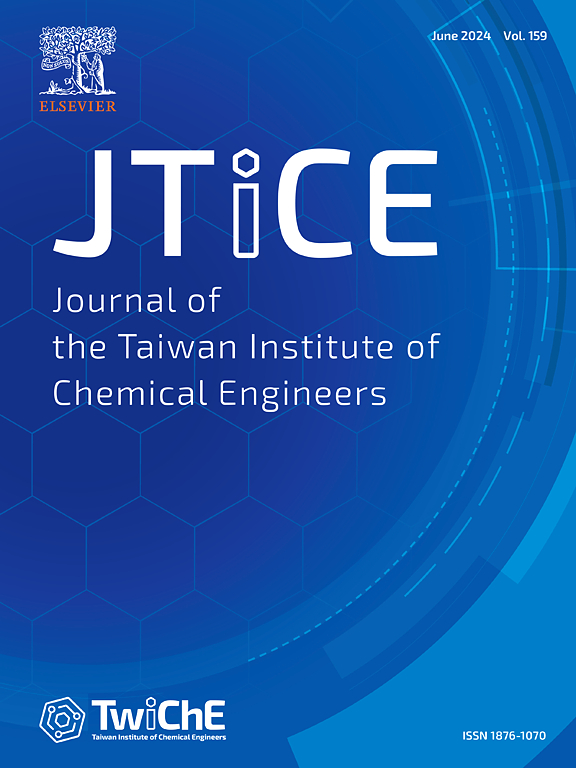Tuning annealing temperature to improve the sensing performance of single-walled carbon nanohorn-modified electrodes for simultaneous detection of ascorbic acid, dopamine, and uric Acid
IF 5.5
3区 工程技术
Q1 ENGINEERING, CHEMICAL
Journal of the Taiwan Institute of Chemical Engineers
Pub Date : 2025-07-12
DOI:10.1016/j.jtice.2025.106296
引用次数: 0
Abstract
Background
Ascorbic acid (AA), dopamine (DA), and uric acid (UA) are essential biomolecules in the human body, and abnormal concentrations can impact overall health. Therefore, developing a highly sensitive sensor capable of simultaneously detecting these three substances is crucial for disease prevention.
Methods
In this study, single-walled carbon nanohorns (SWCNHs) were heat-treated at different annealing temperatures (200 °C-1200 °C) and modified onto a glassy carbon electrode (GCE) for the simultaneous detection of AA, DA, and UA. The influence of annealing temperature on the surface properties of SWCNHs and their sensing performance was thoroughly analyzed.
Significant findings
Among them, SWCNHs annealed at 1200 °C exhibited more defects, enhancing the electrochemically active surface area and significantly improving detection performance. The 1200-SWCNH/GCE electrode demonstrated excellent peak separation. It showed a 3.3-, 3.6-, and 4.0-fold increase in sensitivity compared to the non-annealed electrode, with sensitivities of 0.078 μM/μA, 2.010 μM/μA, and 0.572 μM/μA for AA, DA, and UA, respectively. Additionally, this sensor demonstrated outstanding selectivity, reproducibility, and repeatability. In real sample analysis, the recovery rates for AA, DA, and UA ranged from 99.05 % to 104.03 %, validating the feasibility of 1200-SWCNH/GCE for practical applications.

调整退火温度,提高单壁碳纳米角修饰电极同时检测抗坏血酸、多巴胺和尿酸的传感性能
抗坏血酸(AA)、多巴胺(DA)和尿酸(UA)是人体必需的生物分子,浓度异常会影响整体健康。因此,开发一种能够同时检测这三种物质的高灵敏度传感器对于预防疾病至关重要。方法将单壁碳纳米角(SWCNHs)在不同的退火温度(200°C-1200°C)下进行热处理,并修饰在玻碳电极(GCE)上,用于同时检测AA、DA和UA。深入分析了退火温度对swcnh表面性能和传感性能的影响。其中,1200℃退火的swcnh缺陷较多,电化学活性表面积增强,检测性能显著提高。1200-SWCNH/GCE电极具有良好的峰分离性能。对AA、DA和UA的灵敏度分别为0.078 μM/μA、2.010 μM/μA和0.572 μM/μA,比未退火电极的灵敏度提高3.3倍、3.6倍和4.0倍。此外,该传感器还具有出色的选择性、再现性和可重复性。在实际样品分析中,AA、DA和UA的回收率在99.05% ~ 104.03%之间,验证了1200-SWCNH/GCE在实际应用中的可行性。
本文章由计算机程序翻译,如有差异,请以英文原文为准。
求助全文
约1分钟内获得全文
求助全文
来源期刊
CiteScore
9.10
自引率
14.00%
发文量
362
审稿时长
35 days
期刊介绍:
Journal of the Taiwan Institute of Chemical Engineers (formerly known as Journal of the Chinese Institute of Chemical Engineers) publishes original works, from fundamental principles to practical applications, in the broad field of chemical engineering with special focus on three aspects: Chemical and Biomolecular Science and Technology, Energy and Environmental Science and Technology, and Materials Science and Technology. Authors should choose for their manuscript an appropriate aspect section and a few related classifications when submitting to the journal online.

 求助内容:
求助内容: 应助结果提醒方式:
应助结果提醒方式:


